
Celebrate ten years of Urban Omnibus and support ten more years of fresh, independent perspectives on citymaking with a donation today!
Celebrate ten years of Urban Omnibus and support ten more years of fresh, independent perspectives on citymaking with a donation today!
On Staten Island, a flock of 90-some turkeys — the inspiration for reimagining the grounds of the South Beach Psychiatric Center as a Turkey National Park — is in limbo as an upstate sanctuary scrambles to raise funds to care for the urban fowl. This is your Staten Island Turkey Watch — strike that — your Omnibus Thanksgiving Roundup.
HOLD THE STUFFING
These pieces are meaty enough. Over on City Limits, a series by Batya Ungar Sargon, Making NYCHA: The People Behind The Policy, profiles New York City Housing Authority Chairwoman Shola Olatoye, her predecessor John Rhea, and City Councilmember and Chair of the Committee on Public Housing Ritchie Torres. If you want to get up to speed on the challenges facing the authority — a crucial but embattled bastion of affordability in the city and unique among agencies of its kind in the US — this exploration of the politics and people working to reform the authority amid public blowback and declining federal support is well worth your time.
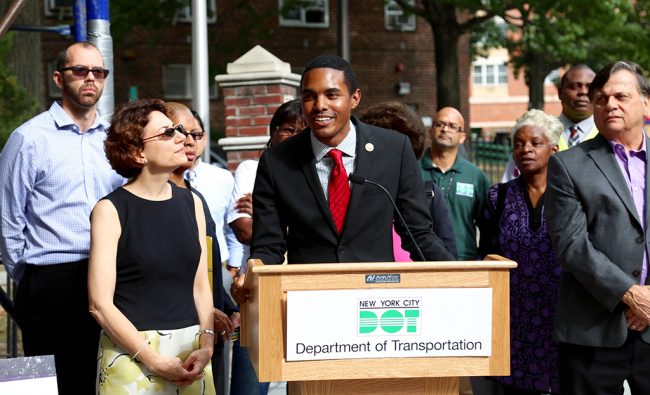
Councilman Ritchie Torres earlier this year announcing newly repaired sidewalks at the Parkside Houses. | Photo via NYC Department of Transportation
New York Magazine might win the award for rabbit hole of the year with One Block, a deep exploration of MacDonough Street between Patchen Avenue and Malcolm X Boulevard in Bed-Stuy, Brooklyn. Hear directly from residents new and old about dramatic changes on their street — jumps in the white population, doubling of housing prices, climbing property taxes, shifts in culture — all while taking in an impressive array of contextual information, from skelly instructions to primers on redlining. For rich accompaniment, take in Weeksville Heritage Center’s online component of their Lost Jazz Shrines of Brooklyn exhibition, complete with oral histories and a multimedia timeline of the many, many jazz venues and musicians that have made Bed-Stuy, Crown Heights, and Fort Greene their homes from 1919 to 2015.
INTO THE VAULT
If you’re a regular Urban Omnibus reader, there’s a fair chance you’re as nerdy as we are about New York City history and the archives that hold its remnants. Last week, Gothamist took a look inside one such repository: the New York City Department of Records and Information Services. Check out their video on the archives tucked across the street from City Hall, complete with peeks at the oldest holding — the deed to Gravesend from 1645 — the conversation lab, and files with enticing names like “Beer for Taxation Parade.” Hankering for more archive talk? Check out Shannon Mattern’s Middlewhere: Landscapes of Library Logistics.
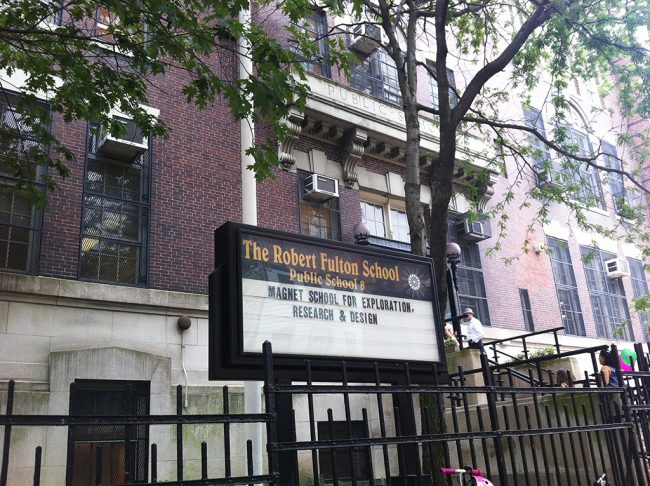
P.S. 8 in Brooklyn Heights | Photo by dumbonyc
STILL SEPARATE, STILL UNEQUAL
New York City claims a lot of superlatives, but a report last year from UCLA’s Civil Rights Project highlighted one of its more troubling distinctions: the city’s school system is arguably the most segregated in the nation. And as investigative reporter Nikole Hannah-Jones told an audience at the Brooklyn Historical Society in September: “We have not yet managed to break that link between race, class, and resources … There’s nothing magical about being in a classroom with white people that makes black kids smart — it’s what they suddenly get.” More opportunities and better qualified teachers, for instance.
Earlier this year, the NYC Department of Education set off a firestorm with proposed rezonings of two sets of school districts, putting the massive racial disparity among the pairs front and center. In Brooklyn, the service area for Vinegar Hill’s P.S. 307 — with a student body that is 90 percent black and Latino — consists almost entirely of NYCHA’s Farragut Houses. Nearby, P.S. 8 in Brooklyn Heights is predominantly white, well-regarded, and severely overcrowded. Adjusting the zone boundaries for the two schools would relieve crowding at P.S. 8, but the proposal has upset many Brooklyn Heights parents whose children would end up zoned for 307, considered an underperforming school by City and State metrics.
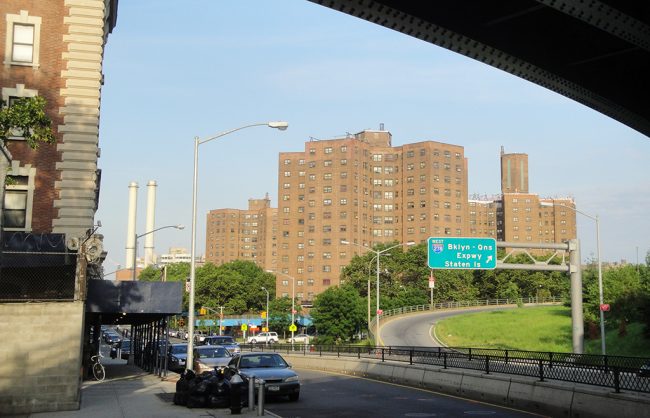
The Farragut Houses are zoned for P.S. 307 in Vinegar Hill. | Photo by zeromirabilis
At stake in Vinegar Hill are a tight-knit community and prized STEM and foreign language programs that rely on Title I funding reserved for low-income students — support an influx of wealthier and whiter Heights residents could jeopardize. After tweaks to the rezoning proposal meant to ensure seats for disadvantaged students at P.S. 307 (anticipating further gentrification of northwest Brooklyn), the local Community Education Council is expected to render the decisive vote on the proposal in early January.
Across the East River, a similar proposal for P.S. 199 and P.S. 191 on the Upper West Side was shelved last week after the DOE was “unable to reach consensus on the best course of action,” according to a spokesperson. In a separate announcement, the department unveiled a diversity initiative for seven elementary schools that, in the vein of the P.S. 307 proposal, will set aside seats for children from low-income and non-English speaking families.
BRING OUT THE MAPS! (AND OTHER VISUALIZATIONS)
National Geographic depicts Manhattan’s rapidly growing future skyline. | MapZen bends the New York metro area. | ANHD charts economies, neighborhood by neighborhood. | Check out the finalists from CartoDB’s Insight mapping competition — smells, housing, waste, oh my!
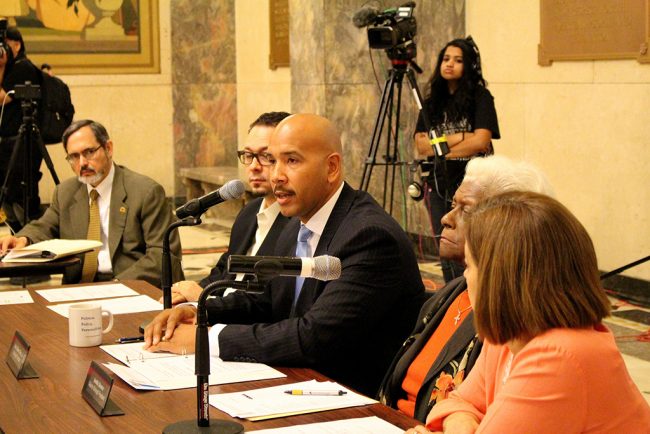
Bronx Borough President Ruben Diaz Jr. met last week with the Borough Board to discuss Mayor de Blasio’s housing proposals. | Photo via Office of Borough President Diaz
ALPHABET SOUP, SENT BACK
Amid the litany of acronyms thrown around in public policy, two three-letter ones are causing a stir across the five boroughs this fall: MIH and ZQA. Mandatory Inclusionary Housing and Zoning for Quality and Affordability are two major components of Mayor de Blasio’s low- and moderate-income housing plan. The former requires 25 to 30 percent of units in new residential development in upzoned neighborhoods to be affordable; the latter revises the zoning code to, among other changes, increase height limits in certain districts and reduce or eliminate some parking requirements in transit-rich areas.
The city’s 59 community boards are now casting non-binding votes on the proposed changes, and rejection is a common refrain. In the Bronx, the poorest borough, all 12 community boards have voted against the proposed changes. Opposition stems in part from concerns deep in the current New York zeitgeist — the threat of displacement and mistrust that new housing produced will be truly affordable — while others, like reduced parking and taller building heights, might seem surprising if not looking beyond Manhattan. The negative votes have put the City on the defensive, and the community resistance is having an effect: both Mayor de Blasio and Speaker Melissa Mark-Viverito have spoken out this week promising changes to the citywide proposals before they reach the City Council floor. The Council is expected cast the deciding ballots on MIH and ZQA in early 2016.
STAMP IT OUT
Between 2002 and 2015, smoking rates in New York City declined precipitously, from 21.5 to 13.9 percent of adults. Local laws banning smoking in workplaces, bars, restaurants, hospitals, parks, beaches, and plazas certainly played a part. But a new rule to ban smoking in all public housing facilities, announced earlier this month by the federal Department of Housing and Urban Development, will place new regulations only on the five percent of the city’s population that calls NYCHA housing home. While the ban is unequivocally good for public health, critics argue it’s yet another way to stigmatize and criminalize the poor.
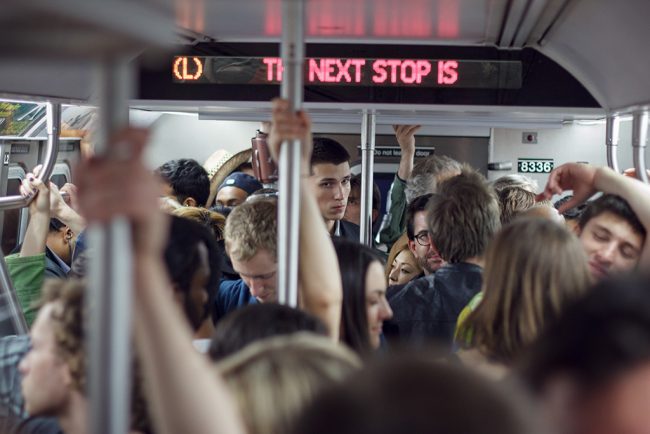
Riders pack an L train | Photo by Michael Semensohn
CHECKING IN WITH OUR FAVORITE TRANSIT AUTHORITY
Last week, New York City Transit, the agency within the Metropolitan Transportation Authority that oversees the city’s buses and subways, announced Veronique Hakim, current head of New Jersey Transit, as its new president. Hakim will face the pressures of growing ridership and a host of ailments in the increasingly strained subway system, among them tired infrastructure, roughly 3,000 monthly train delays due to sick riders, and the conspicuous absence of countdown clocks on the lettered subway lines born of bureaucratic and technical hurdles. But all’s not lost for the daily straphanger: if you find yourself tardy to work or school due to a delayed train, the MTA issues late slips! And with renewed public attention to the many shuttered station entrances across the city, reduced jostling to enter or exit the system may be in your future, with potential benefits to surrounding businesses to boot.
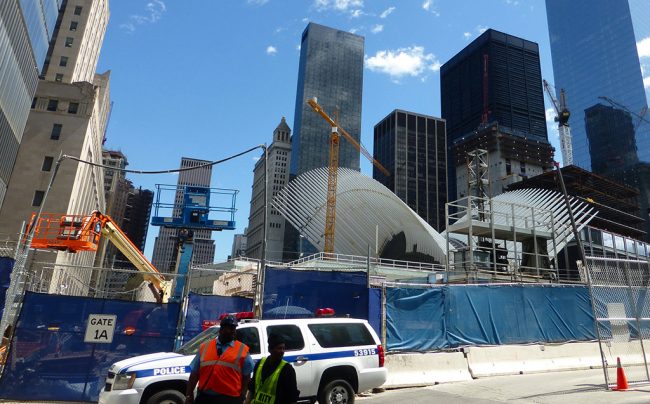
Construction crews earlier this year at the World Trade Center Transportation Hub. | Photo by Lars Igelstrom
WHERE IT ALL STANDS
World Trade Center Redevelopment: Slated to open in time for the holiday shopping season, the Westfield mall at the multibillion-dollar World Trade Center transit hub was dealt another setback, this time due to water leaks. But nearby, the long-stalled plans for a performing arts center take a step forward as Brooklyn-based REX, with help from Davis Brody Bond, are selected to design the future theater, dance, and music space.
A New Trans-Hudson Tunnel: After tensions rose this summer over ongoing inaction to forestall interstate transit doom, federal and state officials have reached an agreement to form a new corporation to oversee the Hudson tunnel. The $20 billion tab will be split four ways between the federal government, New York, New Jersey, and Amtrak.
Willets Point Redevelopment: After the de Blasio administration mounted no defense of a disputed Bloomberg-era project to build a shopping mall, housing, parks, retail, and a hotel on parkland near Citi Field, the development consortium behind the plan rebounded Monday when the New York State Court of Appeals opted to reconsider the decision to stop the $3 billion project cold.
Post-Sandy Resiliency Planning: On December 3, federal and municipal agencies will hold a public meeting to kick off drafting the environmental impact statement for the “Big U,” a Rebuild by Design project to create a network of levees, berms, and adaptable flood walls protecting Lower Manhattan.
Brooklyn Heights Branch Library Redevelopment: Tensions remain high as the City Council nears a vote on a plan to replace a branch library with luxury housing, anchored by a new library at street level, reaping needed funds for the library system in the process.
Long Island College Hospital Redevelopment: In Cobble Hill, Councilman Brad Lander announced his opposition to a plan rezoning the former Long Island College Hospital site, a plan for which the de Blasio administration has indicated its support.
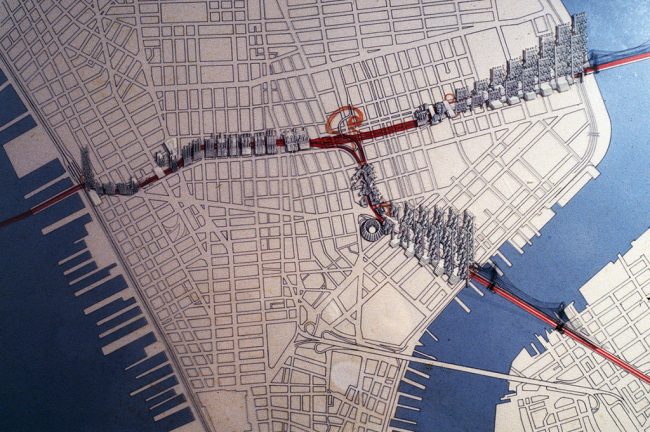
Planned route of Robert Moses’ Lower Manhattan Expressway | Image courtesy of the Paul Rudolph Archive, Library of Congress
STUFF TO DO, WITH EXHIBITIONIST TENDENCIES
If you’re eager for an escape over the holiday, pair a wind-whipped trip to Coney Island with the Brooklyn Museum’s Coney Island: Visions of an American Dreamland, 1861–2008. The just-opened exhibition showcases the many incarnations of the iconic beachside destination through artifacts, photographs, and painting.
Not everything in the City’s Municipal Archives requires an appointment. Visit their exhibition In the Shadow of the Highway: Robert Moses’ Expressway and the Battle for Downtown to delve into the architectural, political, and personal aspects of the Master Builder’s never realized plan for a ten-lane crosstown highway.
Or perhaps you’re yearning for a bit of the suburbs. The Museum of Chinese in America and the New York Public Library’s Schomburg Center for Research in Black Culture each have fascinating shows up on the relationship of suburbia to racial and ethnic identity. SUB URBANISMS: Casino Urbanization, Chinatowns, and the Contested American Landscape “explores the controversial conversion of suburban single-family homes into multi-family communities by immigrant Chinese casino workers in Connecticut.” Black Suburbia: From Levittown to Ferguson plumbs the contradictions, myths, hopes, and pitfalls of the African-American suburban experience.
THANKSGIVING SHOUT-OUT
Before we sign off for the holiday, we’d also like to recognize the kind and talented Jonathan Glass, who starts our days off with a warm “hello” from behind the front desk of our SoHo office building before retiring to Manhattan’s jazz clubs to sketch by night. Many thanks to you, sir.
The Roundup keeps you up to date with topics we’ve featured and other things we think are worth knowing about. Formerly a weekly tradition published every Friday, we now bring you the roundup on an occasional basis.
The views expressed here are those of the authors only and do not reflect the position of The Architectural League of New York.